
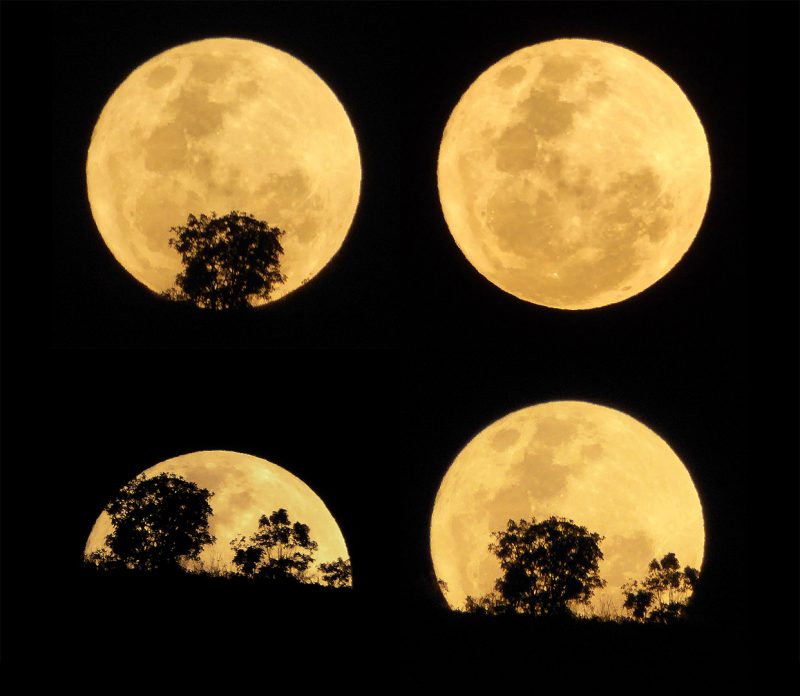
A full supermoon moon rising on December 3, 2017, as captured by Peter Lowenstein in Mutare, Zimbabwe. Supermoons don’t appear noticeably larger than other full moons, but they do appear noticeably brighter! Thank you, Peter!
The full moon on February 9, 2020, ranks as the fourth-closest (and therefore the fourth-largest) of the 13 full moons occurring in the year 2020, but it’s less than certain whether it should be dubbed a supermoon, mainly because commentators disagree on what constitutes a supermoon.
Who are the commentators, and what do they say? The International Astronomical Union (IAU) is the group generally recognized for naming and defining things in astronomy. But the IAU has been, so far, silent on the subject of supermoons, which professional astronomers tend to call perigean full moons.
Meanwhile, Fred Espenak, the go-to astronomer on all things related to lunar and solar eclipses (Mr. Eclipse!), lists the full moon of February 9, 2020, as a supermoon in his post, Full Moon at Perigee.
Click here to learn more about Fred Espenak
We might also consider the astrologer Richard Nolle. Whatever your thoughts or feelings about astrology, Nolle is, after all, the person who coined the term supermoon. He dosen’t include the full moon of February 9, 2020, on his supermoon list. The term supermoon, as defined by Nolle, comes with some ambiguity. That’s why there seems to be some disparity as to which full moons are called supermoons.
Click here to learn more about Richard Nolle
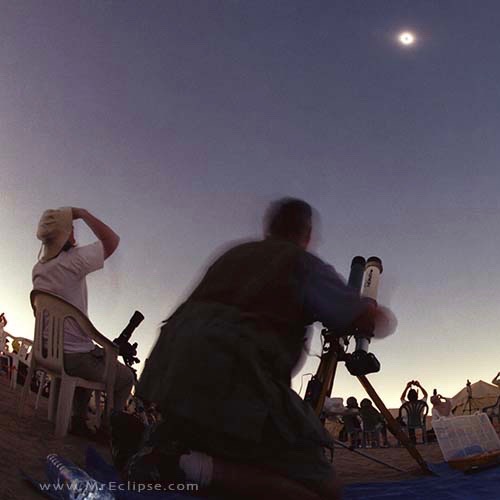
Astrophysicist Fred Espenak, aka Mr. Eclipse – a 30-year NASA veteran and world-renowned expert on eclipses – says the January 12, 2017, full moon was a supermoon in his post Moon in 2017.
We refer you to two different supermoon tables for the 21st century (2001 to 2100). Here is Richard Nolle’s table, and here is Fred Espenak’s table.
Richard Nolle lists only two full moon supermoons for 2020:
2020 March 9
2020 April 8
Meanwhile, Fred Espenak lists four full moon supermoons in 2020:
2020 February 9
2020 March 9
2020 April 8
2020 May 7
Why are their lists different? It all goes back to the definition of the word supermoon.
Here’s one thing we all can agree on. Supermoons are based on lunar perigee and apogee. Each month, the moon comes closest to Earth at perigee and swings farthest away at apogee.
In his original definition, Richard Nolle defined a supermoon as:
… a new or full moon which occurs with the moon at or near (within 90 percent of) its closest approach to Earth in a given orbit.
If a new or full moon aligns with apogee, then it’s at 0 percent of its closest approach to Earth. On the other hand, if a new or full moon aligns with perigee, then it’s at 100 percent of its closest approach to Earth. That’s something we can all agree on.
But the phrase 90 percent of perigee is ambiguous. Read on.

A 2013 supermoon, as captured by EarthSky Facebook friend Anthony Lynch in Dublin, Ireland.
Nolle’s 90 percent is based on 2020’s closest perigee and farthest apogee. Looking at Richard Nolle’s list for all the supermoons in the 21st century, it appears that Richard Nolle might base his 90 percent figure on the year’s closest perigee and farthest apogee. Let’s take the year 2020. Based on the year’s closest perigee and farthest apogee, any new or full moon coming closer than 224,865 miles (361,885 miles) qualifies as a supermoon.
Here are the distances of the four closest full moons in 2020:
Full moon (February 9, 2020): 225,234 miles or 362,479 km
Full moon (March 9, 2020): 222,081 miles or 357,404 km
Full moon (April 8, 2020): 221,851 miles or 357,035 km
Full moon (May 7, 2020): 224,429 miles or 361,184 km
This year, in 2020, the moon swings farthest away from Earth on March 24 (252,707 miles or 406,692 km), and then sweeps closest to Earth one fortnight (two weeks) later, on April 7 (221,772 miles or 356,907 km). That’s a difference of 30,935 miles or 49,785 km. Ninety percent of the difference = 27,842 miles or 44,807 km. Presumably, any new or full moon coming closer than 224,865 miles (361,885 km) would be “at or near (within 90 percent of) its closest approach to Earth.”
Farthest apogee (2020): 252,707 miles (406,692 km)
Closest perigee (2020): 221,772 miles (356,907 km)
Difference (2020): 30,935 miles (49,785 km)
90 percent x 30,935 miles (49,785 km) = 27,842 miles (44,807 km)
90 percent of moon’s closest distance to Earth = 252,707 miles (406,692 km) – 27,942 miles (44,807 km) = 224,865 miles (361,885 km)
Thus, figuring out “90 percent of the moon’s closest approach to Earth” by the year’s closest perigee and farthest apogee, any new or full moon coming closer than 224,865 miles (361,885 km) to Earth, as measured from the centers of the Earth and moon, counts as a supermoon in 2020.
Since the full moon on February 9, 2020, only comes within 225,234 miles (362,479 km) of Earth, it doesn’t count as a supermoon on Richard Nolle’s list. But we’re not quite sure why the full moon of May 7, 2020, didn’t make Nolle’s list.

July 2014 supermoon via Evgeny Yorobe Photography.
Espenak’s 90 percent based on perigee and apogee of each month’s orbit. Ironically, Fred Espenak’s full supermoon list might more strictly adhere to Richard Nolle’s definition (at least as it is written) than Richard Nolle himself does.
Once again, Richard Nolle describes a supermoon as:
… a new or full moon which occurs with the moon at or near (within 90 percent of) its closest approach to Earth in a given orbit.
If given orbit can be taken to mean current monthly orbit, then the February full moon comes to within 95.5 percent of its closest approach to Earth relative to the most recent apogee and the upcoming perigee.
January 29, 2020 apogee: 251,900 miles (405,393 km)
February 10, 2020 perigee: 223,980 miles (360,461 km)
Difference: 27,920 miles (44,932 km)
January 29, 2020 apogee: 251,900 miles (405,393 km)
February 9, 2020 full moon: 225,234 miles (362,479 km)
Difference: 26,666 miles (42,914 km)
26,666/27,920 = 0.955 (99.5 percent) = distance of the February 2020 full moon relative to the most recent apogee and upcoming perigee.
Depending on what meaning we give to the words in a given orbit, we could say the January 29 apogee = 0 percent of the moon’s closest approach to Earth for this orbit, and the February 10 perigee = 100 percent of the moon’s closest approach to Earth.
That being the case, then the February full moon comes to within 95.5 percent of its closest approach to Earth for the month.
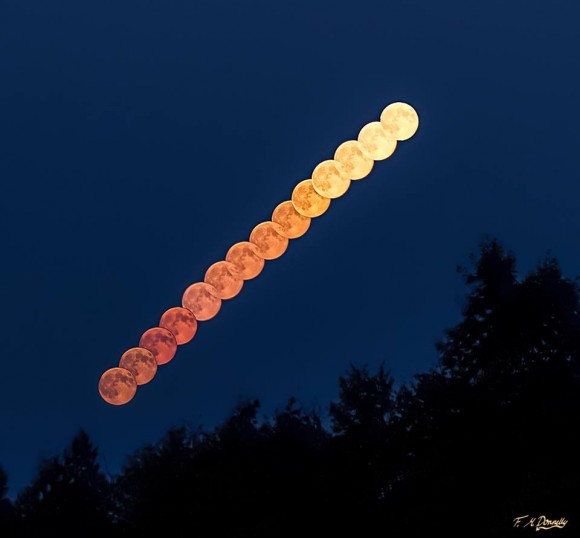
Super cool super-moonrise composite from Fiona M. Donnelly in Ontario. This photo is from the August 2014 supermoon.
February full moon’s distance relative to 2020’s closest perigee/farthest apogee. However, if we compute the percentage distance of the February full moon relative to the year’s farthest apogee and closest perigee, then the February full moon only comes to within 88.8 percent of its closest approach to Earth:
Farthest apogee (2020): 252,707 miles (406,692 km)
Closest perigee (2020): 221,772 miles (356,565 km)
Difference: 30,935 miles (49,785 km)
Farthest apogee (2020): 252,707 miles (406,692 km)
February full moon (2020): 225,234 miles (362,479 km)
Difference (2020): 27,473 miles (44,213 km)
27,473/30,935 = 0.888 (88.8 percent) = distance of the February full moon relative to the year’s farthest apogee and closest perigee.
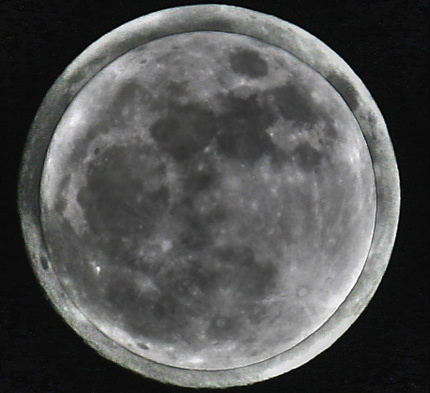
Another contrast of a full supermoon (full moon at perigee) with a micro-moon (full moon at apogee). Image via Stefano Sciarpetti/ APOD.
Is the February full moon a supermoon? Depends on which perigee/apogee distances you choose. The moon’s perigee and apogee distances vary throughout the year, so it appears that the limiting distance for the supermoon depends on which perigee and apogee distances are being used to compute 90 percent of the moon’s closest approach to Earth.
If we choose the year’s closest perigee and farthest apogee, as Nolle did, we narrow the definition of supermoon.
If we choose the perigee and apogee for a given monthly orbit, as Espenak did, then we broaden the definition of supermoon.
Given the narrower definition, the full moon on February 9, 2020, is not a supermoon, but given the broader one, it is.
Take your choice!
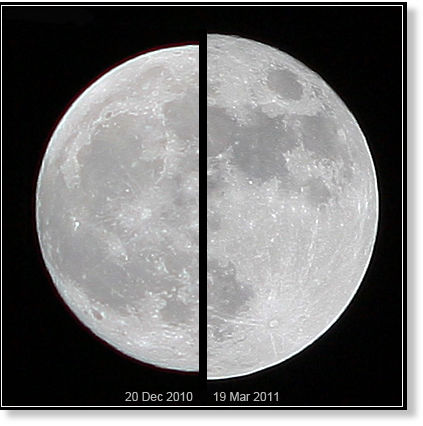
The moon’s apparent size in our sky depends on its distance from Earth. The supermoon of March 19, 2011 (right), compared to an average moon of December 20, 2010 (left). Image by Marco Langbroek of the Netherlands via Wikimedia Commons.
Read more: How many supermoons in 2020?
Bottom line: At least two commentators – Richard Nolle and Fred Espenak – disagree on whether the February 9, 2020, full moon should be called a supermoon. Is it? If you define a supermoon based on the year’s closest perigee and farthest apogee, then the February 2020 full moon is not a supermoon. If you define a supermoon based on the perigee and apogee for a given monthly orbit, then it is a supermoon. Take your choice!
from EarthSky https://ift.tt/2v0MwNw


A full supermoon moon rising on December 3, 2017, as captured by Peter Lowenstein in Mutare, Zimbabwe. Supermoons don’t appear noticeably larger than other full moons, but they do appear noticeably brighter! Thank you, Peter!
The full moon on February 9, 2020, ranks as the fourth-closest (and therefore the fourth-largest) of the 13 full moons occurring in the year 2020, but it’s less than certain whether it should be dubbed a supermoon, mainly because commentators disagree on what constitutes a supermoon.
Who are the commentators, and what do they say? The International Astronomical Union (IAU) is the group generally recognized for naming and defining things in astronomy. But the IAU has been, so far, silent on the subject of supermoons, which professional astronomers tend to call perigean full moons.
Meanwhile, Fred Espenak, the go-to astronomer on all things related to lunar and solar eclipses (Mr. Eclipse!), lists the full moon of February 9, 2020, as a supermoon in his post, Full Moon at Perigee.
Click here to learn more about Fred Espenak
We might also consider the astrologer Richard Nolle. Whatever your thoughts or feelings about astrology, Nolle is, after all, the person who coined the term supermoon. He dosen’t include the full moon of February 9, 2020, on his supermoon list. The term supermoon, as defined by Nolle, comes with some ambiguity. That’s why there seems to be some disparity as to which full moons are called supermoons.
Click here to learn more about Richard Nolle

Astrophysicist Fred Espenak, aka Mr. Eclipse – a 30-year NASA veteran and world-renowned expert on eclipses – says the January 12, 2017, full moon was a supermoon in his post Moon in 2017.
We refer you to two different supermoon tables for the 21st century (2001 to 2100). Here is Richard Nolle’s table, and here is Fred Espenak’s table.
Richard Nolle lists only two full moon supermoons for 2020:
2020 March 9
2020 April 8
Meanwhile, Fred Espenak lists four full moon supermoons in 2020:
2020 February 9
2020 March 9
2020 April 8
2020 May 7
Why are their lists different? It all goes back to the definition of the word supermoon.
Here’s one thing we all can agree on. Supermoons are based on lunar perigee and apogee. Each month, the moon comes closest to Earth at perigee and swings farthest away at apogee.
In his original definition, Richard Nolle defined a supermoon as:
… a new or full moon which occurs with the moon at or near (within 90 percent of) its closest approach to Earth in a given orbit.
If a new or full moon aligns with apogee, then it’s at 0 percent of its closest approach to Earth. On the other hand, if a new or full moon aligns with perigee, then it’s at 100 percent of its closest approach to Earth. That’s something we can all agree on.
But the phrase 90 percent of perigee is ambiguous. Read on.

A 2013 supermoon, as captured by EarthSky Facebook friend Anthony Lynch in Dublin, Ireland.
Nolle’s 90 percent is based on 2020’s closest perigee and farthest apogee. Looking at Richard Nolle’s list for all the supermoons in the 21st century, it appears that Richard Nolle might base his 90 percent figure on the year’s closest perigee and farthest apogee. Let’s take the year 2020. Based on the year’s closest perigee and farthest apogee, any new or full moon coming closer than 224,865 miles (361,885 miles) qualifies as a supermoon.
Here are the distances of the four closest full moons in 2020:
Full moon (February 9, 2020): 225,234 miles or 362,479 km
Full moon (March 9, 2020): 222,081 miles or 357,404 km
Full moon (April 8, 2020): 221,851 miles or 357,035 km
Full moon (May 7, 2020): 224,429 miles or 361,184 km
This year, in 2020, the moon swings farthest away from Earth on March 24 (252,707 miles or 406,692 km), and then sweeps closest to Earth one fortnight (two weeks) later, on April 7 (221,772 miles or 356,907 km). That’s a difference of 30,935 miles or 49,785 km. Ninety percent of the difference = 27,842 miles or 44,807 km. Presumably, any new or full moon coming closer than 224,865 miles (361,885 km) would be “at or near (within 90 percent of) its closest approach to Earth.”
Farthest apogee (2020): 252,707 miles (406,692 km)
Closest perigee (2020): 221,772 miles (356,907 km)
Difference (2020): 30,935 miles (49,785 km)
90 percent x 30,935 miles (49,785 km) = 27,842 miles (44,807 km)
90 percent of moon’s closest distance to Earth = 252,707 miles (406,692 km) – 27,942 miles (44,807 km) = 224,865 miles (361,885 km)
Thus, figuring out “90 percent of the moon’s closest approach to Earth” by the year’s closest perigee and farthest apogee, any new or full moon coming closer than 224,865 miles (361,885 km) to Earth, as measured from the centers of the Earth and moon, counts as a supermoon in 2020.
Since the full moon on February 9, 2020, only comes within 225,234 miles (362,479 km) of Earth, it doesn’t count as a supermoon on Richard Nolle’s list. But we’re not quite sure why the full moon of May 7, 2020, didn’t make Nolle’s list.

July 2014 supermoon via Evgeny Yorobe Photography.
Espenak’s 90 percent based on perigee and apogee of each month’s orbit. Ironically, Fred Espenak’s full supermoon list might more strictly adhere to Richard Nolle’s definition (at least as it is written) than Richard Nolle himself does.
Once again, Richard Nolle describes a supermoon as:
… a new or full moon which occurs with the moon at or near (within 90 percent of) its closest approach to Earth in a given orbit.
If given orbit can be taken to mean current monthly orbit, then the February full moon comes to within 95.5 percent of its closest approach to Earth relative to the most recent apogee and the upcoming perigee.
January 29, 2020 apogee: 251,900 miles (405,393 km)
February 10, 2020 perigee: 223,980 miles (360,461 km)
Difference: 27,920 miles (44,932 km)
January 29, 2020 apogee: 251,900 miles (405,393 km)
February 9, 2020 full moon: 225,234 miles (362,479 km)
Difference: 26,666 miles (42,914 km)
26,666/27,920 = 0.955 (99.5 percent) = distance of the February 2020 full moon relative to the most recent apogee and upcoming perigee.
Depending on what meaning we give to the words in a given orbit, we could say the January 29 apogee = 0 percent of the moon’s closest approach to Earth for this orbit, and the February 10 perigee = 100 percent of the moon’s closest approach to Earth.
That being the case, then the February full moon comes to within 95.5 percent of its closest approach to Earth for the month.

Super cool super-moonrise composite from Fiona M. Donnelly in Ontario. This photo is from the August 2014 supermoon.
February full moon’s distance relative to 2020’s closest perigee/farthest apogee. However, if we compute the percentage distance of the February full moon relative to the year’s farthest apogee and closest perigee, then the February full moon only comes to within 88.8 percent of its closest approach to Earth:
Farthest apogee (2020): 252,707 miles (406,692 km)
Closest perigee (2020): 221,772 miles (356,565 km)
Difference: 30,935 miles (49,785 km)
Farthest apogee (2020): 252,707 miles (406,692 km)
February full moon (2020): 225,234 miles (362,479 km)
Difference (2020): 27,473 miles (44,213 km)
27,473/30,935 = 0.888 (88.8 percent) = distance of the February full moon relative to the year’s farthest apogee and closest perigee.

Another contrast of a full supermoon (full moon at perigee) with a micro-moon (full moon at apogee). Image via Stefano Sciarpetti/ APOD.
Is the February full moon a supermoon? Depends on which perigee/apogee distances you choose. The moon’s perigee and apogee distances vary throughout the year, so it appears that the limiting distance for the supermoon depends on which perigee and apogee distances are being used to compute 90 percent of the moon’s closest approach to Earth.
If we choose the year’s closest perigee and farthest apogee, as Nolle did, we narrow the definition of supermoon.
If we choose the perigee and apogee for a given monthly orbit, as Espenak did, then we broaden the definition of supermoon.
Given the narrower definition, the full moon on February 9, 2020, is not a supermoon, but given the broader one, it is.
Take your choice!

The moon’s apparent size in our sky depends on its distance from Earth. The supermoon of March 19, 2011 (right), compared to an average moon of December 20, 2010 (left). Image by Marco Langbroek of the Netherlands via Wikimedia Commons.
Read more: How many supermoons in 2020?
Bottom line: At least two commentators – Richard Nolle and Fred Espenak – disagree on whether the February 9, 2020, full moon should be called a supermoon. Is it? If you define a supermoon based on the year’s closest perigee and farthest apogee, then the February 2020 full moon is not a supermoon. If you define a supermoon based on the perigee and apogee for a given monthly orbit, then it is a supermoon. Take your choice!
from EarthSky https://ift.tt/2v0MwNw

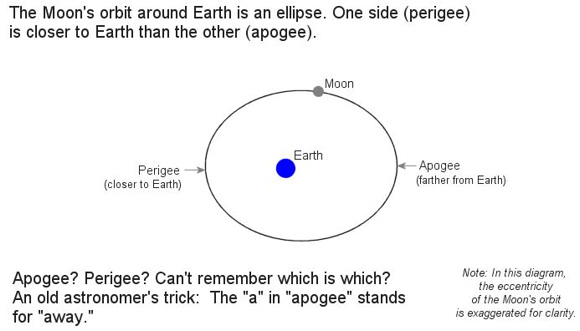
Aucun commentaire:
Enregistrer un commentaire